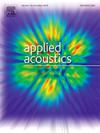Research on jet control and noise reduction mechanism of sound source for leading bogie region
IF 3.4
2区 物理与天体物理
Q1 ACOUSTICS
引用次数: 0
Abstract
In order to achieve sound source reduction in the leading bogie region, turbulent flow and near-filed acoustic pressure were solved based on large eddy simulation and acoustic perturbation equations. The noise control effectiveness of the jet control was confirmed through 1:5 scale high-speed trains model wind tunnel test and the numerical simulation method was validated. The effect of jet control at different positions, velocities and directions were evaluated. Notably, the Bogie-Jet-0.35 V scheme, which involves applying a jet flow at 0.35 times the incoming flow velocity at the leading edge of the bogie, exhibited superior control performance. Compared to the base condition, the optimal scheme achieved optimized control of acoustic and turbulent pressures, resulting in reductions of 2.0 dB and 2.7 dB, respectively. An improved reduced order method based on sample entropy was developed to explore the jet control mechanism. It was found that in the snapshots with high acoustic energy, the acoustic energy was primarily concentrated at the front and rear edges of the bogie. Jet flow reduced the turbulent pressure fluctuation energy near the front wheelset of the bogie. Additionally, jet flow reduced the probability of unsteady flow state transitioning to clusters with high acoustic pressure.
求助全文
约1分钟内获得全文
求助全文
来源期刊

Applied Acoustics
物理-声学
CiteScore
7.40
自引率
11.80%
发文量
618
审稿时长
7.5 months
期刊介绍:
Since its launch in 1968, Applied Acoustics has been publishing high quality research papers providing state-of-the-art coverage of research findings for engineers and scientists involved in applications of acoustics in the widest sense.
Applied Acoustics looks not only at recent developments in the understanding of acoustics but also at ways of exploiting that understanding. The Journal aims to encourage the exchange of practical experience through publication and in so doing creates a fund of technological information that can be used for solving related problems. The presentation of information in graphical or tabular form is especially encouraged. If a report of a mathematical development is a necessary part of a paper it is important to ensure that it is there only as an integral part of a practical solution to a problem and is supported by data. Applied Acoustics encourages the exchange of practical experience in the following ways: • Complete Papers • Short Technical Notes • Review Articles; and thereby provides a wealth of technological information that can be used to solve related problems.
Manuscripts that address all fields of applications of acoustics ranging from medicine and NDT to the environment and buildings are welcome.
 求助内容:
求助内容: 应助结果提醒方式:
应助结果提醒方式:


